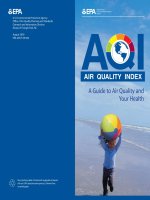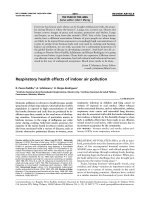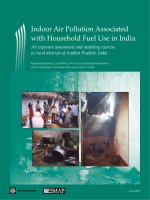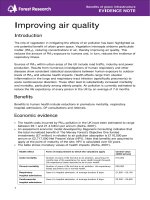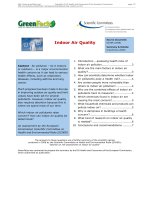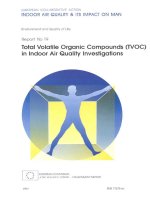Green Facts: Indoor Air Quality doc
Bạn đang xem bản rút gọn của tài liệu. Xem và tải ngay bản đầy đủ của tài liệu tại đây (244.16 KB, 7 trang )
Source document:
Indoor Air Quality
SCHER (2008)
Summary & Details:
GreenFacts (2008)
Context - Air pollution – be it indoors
or outdoors – is a major environmental
Introduction – assessing health risks of
indoor air pollution 3
1.
What are the main factors in indoor air
quality? 3
2.
health concern as it can lead to serious
How can scientists determine whether indoor
air pollutants pose a health risk? 4
3.
health effects, such as respiratory
diseases, including asthma and lung
cancer.
Are certain people more vulnerable than
others to indoor air pollution? 4
4.
Much progress has been made in Europe
in improving outdoor air quality and limit
Why are the combined effects of indoor air
pollutants hard to measure? 4
5.
values have been set for several
Which chemicals found in indoor air are
causing the most concern? 5
6.
pollutants. However, indoor air quality
also requires attention because this is
where we spend most of our time.
What household chemicals and products can
pollute indoor air? 5
7.
Which indoor air pollutants raise
concern? How can indoor air quality be
determined?
Why is dampness in buildings a health
concern? 6
8.
What kind of research on indoor air quality
is needed? 6
9.
An assessment by the European
Commission Scientific Committee on
Health and Environmental Risks (SCHER)
Conclusions and recommendations 710.
The answers to these questions are a faithful summary of the scientific opinion
produced in 2008 by the Scientific Committee on Health and Environmental Risks (SCHER):
"Opinion on risk assessment on indoor air quality"
GreenFacts was contracted to prepare this summary by the DG Health and Consumers of the European Commission,
which authorised its publication.
page 1/7Copyright © DG Health and Consumers of the European Commission. /> />The full publication is available at: />and at: />This PDF Document is the Level 1 of a GreenFacts Co-Publication. GreenFacts Co-Publications are published
in several languages as questions and answers, in a copyrighted user-friendly Three-Level Structure of
increasing detail:
• Each question is answered in Level 1 with a short summary.
• These answers are developed in more detail in Level 2.
• Level 3 consists of the Source document, the internationally recognised scientific opinion which
is faithfully summarised in Level 2 and further in Level 1.
All GreenFacts Co-Publications are available at: />and at: />page 2/7Copyright © DG Health and Consumers of the European Commission. /> />1. Introduction – assessing health risks of indoor air pollution
Several household
cleaning products emit
chemicals
Credit: Sanja Gjenero
Indoor exposure to air pollutants may occur in both private and
public indoor environments such as homes, offices, schools and
transport systems.
Some indoor air pollutants come from the outside, but most are
released inside the building, for example when cleaning or when
burning fuel for cooking and heating. Furniture and construction
materials can also emit pollutants. Dampness and lack of ventilation
may further increase indoor air pollution.
Because indoor air can contain a mixture of many different pollutants, it is very difficult to
assess the associated risks to health. Moreover, there is no such thing as a “typical indoor
environment”.
This opinion considers how health risks of indoor air pollutants are currently evaluated and
how they should be assessed in the future, taking into account simultaneous exposure to
multiple pollutants and particularly vulnerable groups of population such as children, pregnant
women and elderly people.
2. What are the main factors in indoor air quality?
Pets and pests are
sources of allergens
Credit: Katya Foldvaryove
Certain chemicals from household products and home appliances
are known to irritate the eyes, nose and throat. However, for many
chemicals present in indoor air information is lacking on possible
health effects of long term exposure, such as cancer or reproductive
effects.
Radon occurs naturally in parts of Europe. It can get inside buildings
and may lead to lung cancer.
Suspended particles can cause harmful effects on health,
particularly on the respiratory system.
Microbes, such as moulds and viruses, can contribute to the development of asthma and
allergies.
Pets and pests such as dust mites, cockroaches, and mice, are important indoor sources
of allergens.
Low humidity causes eye irritation, dryness of the skin and the nose, and rashes, while
high humidity fosters the growth of moulds and dust mites.
Insufficient ventilation, one of the most important factors in poor indoor air quality, may
affect health and work performance.
Indoor temperatures that are too high or too low are unpleasant and can be unhealthy.
page 3/7Copyright © DG Health and Consumers of the European Commission. /> />3. How can scientists determine whether indoor air pollutants pose a health
risk?
To determine whether pollutants may cause health effects, it is necessary to consider four
aspects:
• Toxicity of pollutants and their concentrations in indoor air. Indoor air can
for instance contain organic compounds, particles, or microbes that may cause
allergies or other health effects.
• Exposure. People are mainly exposed to air pollutants when breathing but may
also be exposed via other routes, such as dust ingestion. Since exposures can
vary, even very low and very high exposures should be considered and not only
average ones.
• Exposure-response relationships. To assess the risk posed by a given
pollutant, it is important to know how the body responds to different
concentrations in air. Health effects observed in people who have been exposed
to pollutants at work are valuable in determining the risks posed by a particular
pollutant. However, such findings may not be directly applicable to the general
public.
• Risk characterisation. In the final step of the risk assessment process, all the
collected scientific evidence is analysed to determine the probability that a
specific pollutant will cause illness.
4. Are certain people more vulnerable than others to indoor air pollution?
Some people are more
vulnerable than others to
indoor air pollution
Credit: Stephan Czuratis
Population groups that are potentially more vulnerable than others
to indoor air pollution are children, pregnant women, elderly people,
and people suffering from cardiovascular or respiratory diseases.
Depending on their age, children may be more vulnerable than adults
to certain toxic substances, like lead and tobacco smoke. Even at
low levels, air pollutants may disrupt the development of their lungs,
cause cough, bronchitis and other respiratory diseases, and make
asthma worse.
Factors other than age and presence of cardiovascular or respiratory
diseases that may render some people more vulnerable are genetic
traits, lifestyle, nutrition and other health problems.
5. Why are the combined effects of indoor air pollutants hard to measure?
Like outdoor air, indoor air contains a complex mixture of pollutants (chemical substances,
allergens and microbes) from different sources that changes with time.
Findings on the health effects of single air pollutants cannot necessarily be extended to
mixtures. Indeed, different chemicals may interact with each other and cause more (or
less) harmful effects than the sum of the effects caused by each chemical separately. Very
little is known about the combined effects of indoor air pollutants.
Risk assessments which take into account the combined exposure and cumulative effects
of the pollutants in indoor air are seldom possible. Nonetheless, the possibility of combined
effects should be considered in the risk assessment taking a case-by-case approach.
page 4/7Copyright © DG Health and Consumers of the European Commission. /> />6. Which chemicals found in indoor air are causing the most concern?
Tobacco Smoke contains
several types of harmful
pollutants
Credit: Vildan Uysal
Among the combustion products that are generated by heating
systems and other home appliances using gas, fuel, or wood, carbon
monoxide (CO) and nitrogen dioxide (NO
2
) are of special
concern.
Tobacco smoke contains several types of harmful pollutants,
including benzene and fine and ultrafine particles. In adults, passive
smoking can cause irritation, aggravated respiratory symptoms, and
coronary heart disease. In children, it can lead to sudden death
syndrome and middle ear infections.
Radon occurs naturally in certain regions. It can get inside buildings
and may lead to lung cancer.
Lead, which is still present in paintwork of some old houses, is harmful to children even at
low level exposure.
Organophosphate pesticides, which are often used against insects in the home, can
affect the development of the nervous system and could be of concern for children.
Volatile organic compounds (VOCs) such as benzene, formaldehyde and naphthalene
which are known to have health effects are emitted by many consumer products. VOCs
may react with ground-level ozone to form secondary pollutants that can cause irritation.
Altogether, the concentrations of VOCs and ozone causing mixture effects are as yet poorly
known.
7. What household chemicals and products can pollute indoor air?
Certain paints emit
chemicals
Credit: Daniel Case
Several household consumer products emit chemicals into air, for
instance cleaning products, floor care products, furniture and
household fabrics, air fresheners, glues, paints, paint strippers,
personal care products, printed matter, electronic equipment, candles
and incense.
Some studies show a link between the use of consumer products
and adverse health effects. However, it is not clear to what extent
pollutants are responsible for the observed effects because other
factors may also contribute to them.
A recent study investigated the emissions of chemicals from a large number of different
consumer products. Although typical levels in indoor air were in most cases acceptable, in
some occasions, accepted limits were exceeded.
page 5/7Copyright © DG Health and Consumers of the European Commission. /> />8. Why is dampness in buildings a health concern?
Humidity promotes the
growth of moulds
Credit: Infrogmation
The majority of the health effects linked to dampness and moisture
of buildings are those of the respiratory system. They range from
irritation of mucous membranes, respiratory symptoms, and
infections to diseases such as asthma and allergy. However, it is still
not known precisely how dampness leads to these symptoms and
which are the main substances responsible.
Humidity problems in buildings may originate from leaks,
condensation, or the ground. Excess humidity promotes the growth of micro-organisms
such as moulds and bacteria that lead to release of pollutants into indoor air.
Inadequate ventilation may increase humidity and the levels of pollutants.
Further research is needed to assess how serious or widespread the problem of building
dampness and moisture is at EU level.
9. What kind of research on indoor air quality is needed?
It is necessary to
investigate how people
are exposed to pollutants
in indoor air
9.1 The data available for risk assessment of indoor air pollution
are scarce and often insufficient. Information is available on the
concentrations in indoor air of some well-known pollutants but is
lacking for others whose effects are unclear. Measurements of
outdoor air quality cannot be extrapolated to predict the
concentrations in buildings.
Monitoring of indicators other than concentrations may be helpful,
for instance ventilation rates, general cleanliness, and signs of
dampness. The development of health-based guideline values is
recommended for key pollutants.
9.2 Existing data on exposure to indoor pollutants and information on risk assessment
strategies should be collected and organised.
Research is needed to identify the main sources of indoor pollutants, including in damp and
water-damaged buildings. In addition, it is necessary to investigate how people are exposed
to pollutants in indoor air and how the exposure levels could be measured or estimated
using computer models.
9.3 There is a need for research on the health effects of mixtures of pollutants and of
less well known indoor air pollutants such as microbes. The contribution of indoor air
pollutants to childhood respiratory diseases, as well as the exposure-response relationships,
especially in vulnerable groups, should also be investigated further.
9.4 Existing measurement standards should be validated and harmonised.
page 6/7Copyright © DG Health and Consumers of the European Commission. /> />10. Conclusions and recommendations
Assessing the health risks of indoor air pollution is very difficult as indoor air may contain
over 900 chemicals, particles and biological materials with potential health effects. Factors
like ventilation, cleaning conditions, building characteristics, products used in households,
cultural habits, climate and outdoor environment all influence indoor air quality. Therefore,
large variations can be expected across the EU.
The European Commission Scientific Committee on Health and Environmental Risks (SCHER)
concludes:
• The principles used in the EU for risk assessment of chemicals should also be
applied to indoor air.
• More research and data are needed, particularly on particles and microbes,
volatile organic compounds from consumer products, building dampness, levels
of exposure, and effects on vulnerable populations.
• Gaps in knowledge should be addressed by European-wide multidisciplinary
research. (see question 9)
• Indoor air pollutants of particular concern are carbon monoxide, formaldehyde,
benzene, nitrogen oxides, naphthalene, environmental tobacco smoke, radon,
lead and organophosphate pesticides.
The SCHER also recommends:
• Data on combined effects of indoor pollutants should be gathered.
• All possible routes of exposure should be considered.
• Health-based guideline values for key pollutants and other practical guidance
should be developed.
• The impact of indoor exposure should be considered when evaluating the health
effects of outdoor air pollution.
• All relevant sources known to contribute to indoor air pollution should be
evaluated.
page 7/7Copyright © DG Health and Consumers of the European Commission. /> />

